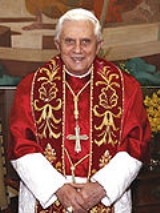
of Rome
, a position that makes him the leader of the worldwide Catholic Church (which is composed of the Latin Rite and the Eastern Catholic Churches in full communion
with the see
of Rome). In the Catholic Church, the Pope is regarded as the successor of Saint Peter
, the Apostle. The current office-holder is Pope Benedict XVI
, who was elected in a papal conclave
on 19 April 2005.
The office of the pope is known as the Papacy.
314 Silvester I begins his reign as Pope of the Catholic Church, succeeding Pope Miltiades.
336 Pope Mark dies, leaving the papacy vacant.
904 Sergius III comes out of retirement to take over the papacy from the deposed antipope Christopher.
1048 Protestantism: The villagers around today's Baden-Baden elect their own priest in defiance of the local bishop. Later, in a move that would not be seen before the Protestant Reformation, he is also elected Pope by acclamatio, just to die that same day. It is rumored that Ildebrando di Soana heard of the acclamatio and used it later to get elected himself as Pope Gregory VII.
1215 King John of England makes an oath to Pope Innocent III as a crusader to gain his support.
1274 In France, the Second Council of Lyons opens to regulate the election of the Pope.
1294 Saint Celestine V resigns the papacy after only five months; Celestine hoped to return to his previous life as an ascetic hermit.
1294 Pope Boniface VIII is elected Pope, replacing St. Celestine V, who had resigned.
1527 Spanish and German troops sack Rome; some consider this the end of the Renaissance. 147 Swiss Guards, including their commander, die fighting the forces of Charles V in order to allow Pope Clement VII to escape into Castel Sant'Angelo.
1590 Pope Urban VII dies 13 days after being chosen as the Pope, making his reign the shortest papacy in history.

